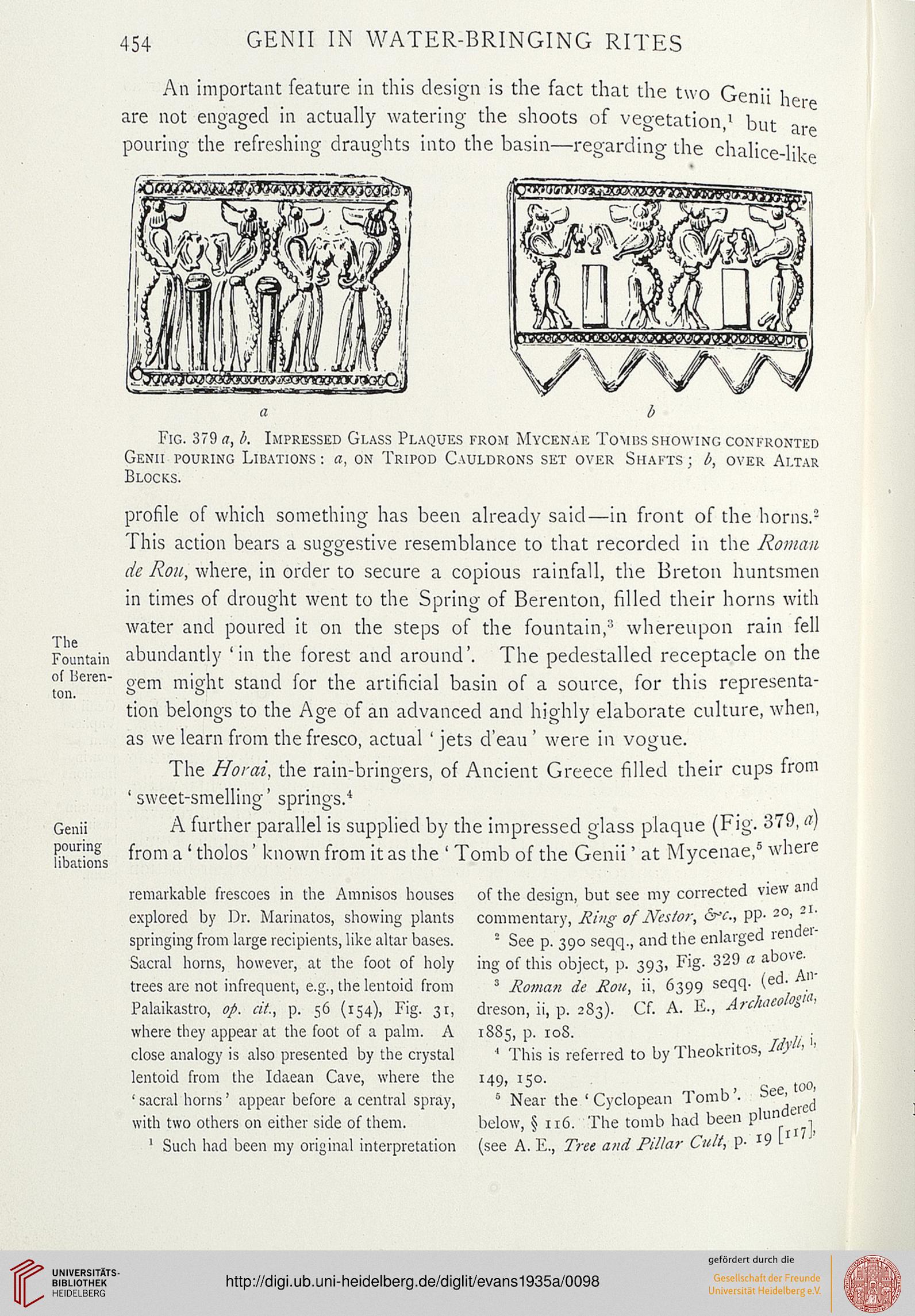454
GENII IN WATER-BRINGING RITES
An important feature in this design is the fact that the two Genii ]
are not engaged in actually watering the shoots of vegetation,1 but
pouring the refreshing draughts into the basin—regarding the chalice-lil-
The
Fountain
of Beren-
Genii
pouring
libations
Fig. 379 a, b. Impressed Glass Plaques from Mycenae Tombs showing confronted
Genii pouring Libations : a, on Tripod Cauldrons set over Shafts ; b, over Altar
Blocks.
profile of which something has been already said—in front of the horns.2
This action bears a suggestive resemblance to that recorded in the Roman,
de Ron, where, in order to secure a copious rainfall, the Breton huntsmen
in times of drought went to the Spring of Berenton, filled their horns with
water and poured it on the steps of the fountain,3 whereupon rain fell
abundantly 'in the forest and around'. The pedestalled receptacle on the
gem might stand for the artificial basin of a source, for this representa-
tion belongs to the Age of an advanced and highly elaborate culture, when,
as we learn from the fresco, actual 'jets d'eau ' were in vogue.
The Horai, the rain-bringers, of Ancient Greece filled their cups from
' sweet-smelling' springs.4
A further parallel is supplied by the impressed glass plaque (Fig. 379, a)
from a ' tholos' known from it as the ' Tomb of the Genii' at Mycenae,5 where
remarkable frescoes in the Amnisos houses
explored by Dr. Marinatos, showing plants
springing from large recipients, like altar bases.
Sacral horns, however, at the foot of holy
trees are not infrequent, e.g., the lentoid from
Palaikastro, op. at, p. 56 (154), Fig. 31,
where they appear at the foot of a palm. A
close analogy is also presented by the crystal
lentoid from the Idaean Cave, where the
' sacral horns' appear before a central spray,
with two others on either side of them.
1 Such had been my original interpretation
of the design, but see my corrected view and
commentary, Ring of Nestor, &"c, pp. 2°. "•
•- See p. 390 seqq, and the enlarged render-
ing of this object, p. 393, Fig. 329 a above.
3 Roman ie Ron, it, 6399 secW' (ed'
dreson, ii, p. 283). Cf. A. E., Arclmeolof:
188
5>P-
10S.
'Phis is referred to by Theokritos, ttj '•''
I49, 15°- -,. , ■ See too,
« Near the ' Cyclopean 1 omb . Bt ' d
below, § 116. The tomb had been Plun i
(see A. E., Tree and Pillar Cult, p- '9 I1 <>'
GENII IN WATER-BRINGING RITES
An important feature in this design is the fact that the two Genii ]
are not engaged in actually watering the shoots of vegetation,1 but
pouring the refreshing draughts into the basin—regarding the chalice-lil-
The
Fountain
of Beren-
Genii
pouring
libations
Fig. 379 a, b. Impressed Glass Plaques from Mycenae Tombs showing confronted
Genii pouring Libations : a, on Tripod Cauldrons set over Shafts ; b, over Altar
Blocks.
profile of which something has been already said—in front of the horns.2
This action bears a suggestive resemblance to that recorded in the Roman,
de Ron, where, in order to secure a copious rainfall, the Breton huntsmen
in times of drought went to the Spring of Berenton, filled their horns with
water and poured it on the steps of the fountain,3 whereupon rain fell
abundantly 'in the forest and around'. The pedestalled receptacle on the
gem might stand for the artificial basin of a source, for this representa-
tion belongs to the Age of an advanced and highly elaborate culture, when,
as we learn from the fresco, actual 'jets d'eau ' were in vogue.
The Horai, the rain-bringers, of Ancient Greece filled their cups from
' sweet-smelling' springs.4
A further parallel is supplied by the impressed glass plaque (Fig. 379, a)
from a ' tholos' known from it as the ' Tomb of the Genii' at Mycenae,5 where
remarkable frescoes in the Amnisos houses
explored by Dr. Marinatos, showing plants
springing from large recipients, like altar bases.
Sacral horns, however, at the foot of holy
trees are not infrequent, e.g., the lentoid from
Palaikastro, op. at, p. 56 (154), Fig. 31,
where they appear at the foot of a palm. A
close analogy is also presented by the crystal
lentoid from the Idaean Cave, where the
' sacral horns' appear before a central spray,
with two others on either side of them.
1 Such had been my original interpretation
of the design, but see my corrected view and
commentary, Ring of Nestor, &"c, pp. 2°. "•
•- See p. 390 seqq, and the enlarged render-
ing of this object, p. 393, Fig. 329 a above.
3 Roman ie Ron, it, 6399 secW' (ed'
dreson, ii, p. 283). Cf. A. E., Arclmeolof:
188
5>P-
10S.
'Phis is referred to by Theokritos, ttj '•''
I49, 15°- -,. , ■ See too,
« Near the ' Cyclopean 1 omb . Bt ' d
below, § 116. The tomb had been Plun i
(see A. E., Tree and Pillar Cult, p- '9 I1 <>'





